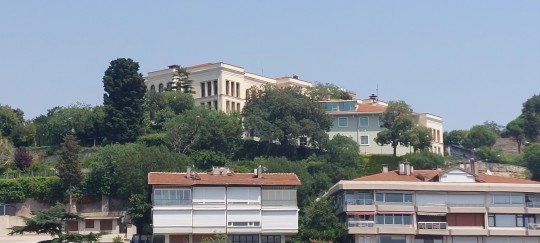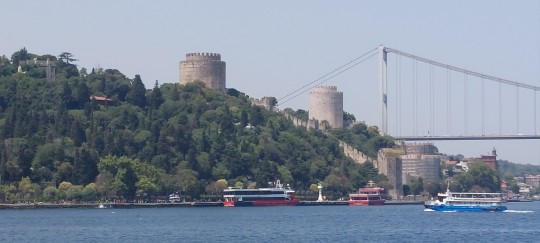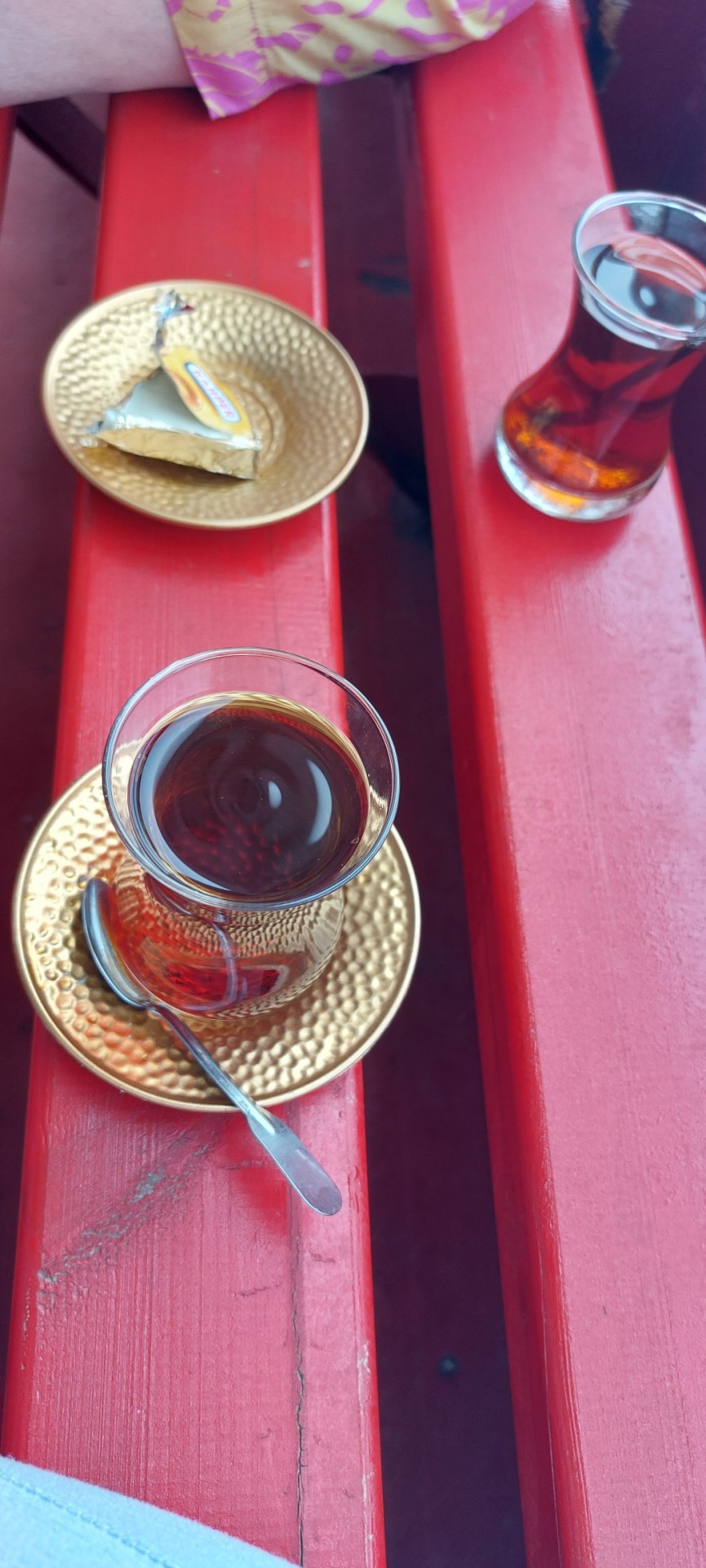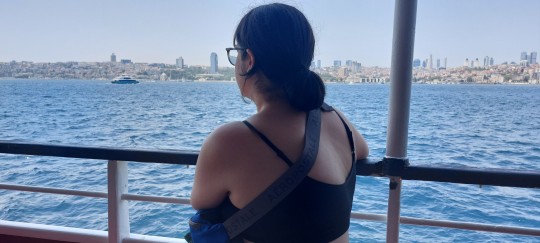#Rumeli Hissar citadel
Text








#istanbul#turkey#local tourism#travel#bosphorus#marmara sea#kuleli#beylerbeyi#rumeli hisari#rumeli hissar citadel#turkish tea#tea time
0 notes
Photo

Rumeli Hissar citadel
Arnaut Keui, the next place the steamer calls at, is the Byzantine Michaelion, built on the site of the more ancient Hestiae. Its Byzantine name was derived from the church erected there to St. Michael by Constantine and rebuilt afterwards by Justinian, and pulled down by Muhammad II., who used the materials for building Rumeli Hissar citadel.
The current at the cape above the landing-stage sets with a velocity of 4 knots an hour, and is called Mega Reuma (‘ strong current ’) by the Greeks, who extend that name to the village also. Boatmen proceeding up the Bosporus find it more expedient to get out and tow past the cape. The Imperial Kiosk, with the lanterns on each side of the door, at the end of the quay is not used now. The charming villa farther on, near the next station, belongs to the sons of the late Egyptian Prince Halim.
Rebek, which comes next after Arnaut Keui, is built on the site of ancient Chelae. In the adjoining bay once stood a temple to Diana Dictynna. The picturesque situation of the place and the beauty of the surrounding scenery made it a favourite resort of various sultans, especially Sultan Selim I. and Selim III., the first of whom built a summer palace on the water-side, known to Europeans as the Palace of Conferences, where ambassadors were received in secret audience. On the top of the hill is the handsome college founded by Mr. A. Robert of Hew York in 1863, and called Robert College after him.
The high road from Pera stops at Bebek. The cemetery lying between the village and Robert College is highly venerated by the Turks, as being the last resting-place of the first of their race who crossed into Europe from Asia, whom they are wont to style Sehid (martyrs) or Evlia (saints). On the top of the hill is a monastery of Bektashl Dervishes, commanding a splendid view.
Rumeli Hissar, or the Citadel of Europe, the next station, is a village mostly inhabited by Turks. The water-gates seen under the houses are to admit boats belonging to the house into the cellars, which in Bosporus water-side residences are generally used as boat-houses.
0 notes
Photo

Rumeli Hissar citadel
Arnaut Keui, the next place the steamer calls at, is the Byzantine Michaelion, built on the site of the more ancient Hestiae. Its Byzantine name was derived from the church erected there to St. Michael by Constantine and rebuilt afterwards by Justinian, and pulled down by Muhammad II., who used the materials for building Rumeli Hissar citadel.
The current at the cape above the landing-stage sets with a velocity of 4 knots an hour, and is called Mega Reuma (‘ strong current ’) by the Greeks, who extend that name to the village also. Boatmen proceeding up the Bosporus find it more expedient to get out and tow past the cape. The Imperial Kiosk, with the lanterns on each side of the door, at the end of the quay is not used now. The charming villa farther on, near the next station, belongs to the sons of the late Egyptian Prince Halim.
Rebek, which comes next after Arnaut Keui, is built on the site of ancient Chelae. In the adjoining bay once stood a temple to Diana Dictynna. The picturesque situation of the place and the beauty of the surrounding scenery made it a favourite resort of various sultans, especially Sultan Selim I. and Selim III., the first of whom built a summer palace on the water-side, known to Europeans as the Palace of Conferences, where ambassadors were received in secret audience. On the top of the hill is the handsome college founded by Mr. A. Robert of Hew York in 1863, and called Robert College after him.
The high road from Pera stops at Bebek. The cemetery lying between the village and Robert College is highly venerated by the Turks, as being the last resting-place of the first of their race who crossed into Europe from Asia, whom they are wont to style Sehid (martyrs) or Evlia (saints). On the top of the hill is a monastery of Bektashl Dervishes, commanding a splendid view.
Rumeli Hissar, or the Citadel of Europe, the next station, is a village mostly inhabited by Turks. The water-gates seen under the houses are to admit boats belonging to the house into the cellars, which in Bosporus water-side residences are generally used as boat-houses.
0 notes
Photo

Rumeli Hissar citadel
Arnaut Keui, the next place the steamer calls at, is the Byzantine Michaelion, built on the site of the more ancient Hestiae. Its Byzantine name was derived from the church erected there to St. Michael by Constantine and rebuilt afterwards by Justinian, and pulled down by Muhammad II., who used the materials for building Rumeli Hissar citadel.
The current at the cape above the landing-stage sets with a velocity of 4 knots an hour, and is called Mega Reuma (‘ strong current ’) by the Greeks, who extend that name to the village also. Boatmen proceeding up the Bosporus find it more expedient to get out and tow past the cape. The Imperial Kiosk, with the lanterns on each side of the door, at the end of the quay is not used now. The charming villa farther on, near the next station, belongs to the sons of the late Egyptian Prince Halim.
Rebek, which comes next after Arnaut Keui, is built on the site of ancient Chelae. In the adjoining bay once stood a temple to Diana Dictynna. The picturesque situation of the place and the beauty of the surrounding scenery made it a favourite resort of various sultans, especially Sultan Selim I. and Selim III., the first of whom built a summer palace on the water-side, known to Europeans as the Palace of Conferences, where ambassadors were received in secret audience. On the top of the hill is the handsome college founded by Mr. A. Robert of Hew York in 1863, and called Robert College after him.
The high road from Pera stops at Bebek. The cemetery lying between the village and Robert College is highly venerated by the Turks, as being the last resting-place of the first of their race who crossed into Europe from Asia, whom they are wont to style Sehid (martyrs) or Evlia (saints). On the top of the hill is a monastery of Bektashl Dervishes, commanding a splendid view.
Rumeli Hissar, or the Citadel of Europe, the next station, is a village mostly inhabited by Turks. The water-gates seen under the houses are to admit boats belonging to the house into the cellars, which in Bosporus water-side residences are generally used as boat-houses.
0 notes
Photo

Rumeli Hissar citadel
Arnaut Keui, the next place the steamer calls at, is the Byzantine Michaelion, built on the site of the more ancient Hestiae. Its Byzantine name was derived from the church erected there to St. Michael by Constantine and rebuilt afterwards by Justinian, and pulled down by Muhammad II., who used the materials for building Rumeli Hissar citadel.
The current at the cape above the landing-stage sets with a velocity of 4 knots an hour, and is called Mega Reuma (‘ strong current ’) by the Greeks, who extend that name to the village also. Boatmen proceeding up the Bosporus find it more expedient to get out and tow past the cape. The Imperial Kiosk, with the lanterns on each side of the door, at the end of the quay is not used now. The charming villa farther on, near the next station, belongs to the sons of the late Egyptian Prince Halim.
Rebek, which comes next after Arnaut Keui, is built on the site of ancient Chelae. In the adjoining bay once stood a temple to Diana Dictynna. The picturesque situation of the place and the beauty of the surrounding scenery made it a favourite resort of various sultans, especially Sultan Selim I. and Selim III., the first of whom built a summer palace on the water-side, known to Europeans as the Palace of Conferences, where ambassadors were received in secret audience. On the top of the hill is the handsome college founded by Mr. A. Robert of Hew York in 1863, and called Robert College after him.
The high road from Pera stops at Bebek. The cemetery lying between the village and Robert College is highly venerated by the Turks, as being the last resting-place of the first of their race who crossed into Europe from Asia, whom they are wont to style Sehid (martyrs) or Evlia (saints). On the top of the hill is a monastery of Bektashl Dervishes, commanding a splendid view.
Rumeli Hissar, or the Citadel of Europe, the next station, is a village mostly inhabited by Turks. The water-gates seen under the houses are to admit boats belonging to the house into the cellars, which in Bosporus water-side residences are generally used as boat-houses.
0 notes
Photo

Rumeli Hissar citadel
Arnaut Keui, the next place the steamer calls at, is the Byzantine Michaelion, built on the site of the more ancient Hestiae. Its Byzantine name was derived from the church erected there to St. Michael by Constantine and rebuilt afterwards by Justinian, and pulled down by Muhammad II., who used the materials for building Rumeli Hissar citadel.
The current at the cape above the landing-stage sets with a velocity of 4 knots an hour, and is called Mega Reuma (‘ strong current ’) by the Greeks, who extend that name to the village also. Boatmen proceeding up the Bosporus find it more expedient to get out and tow past the cape. The Imperial Kiosk, with the lanterns on each side of the door, at the end of the quay is not used now. The charming villa farther on, near the next station, belongs to the sons of the late Egyptian Prince Halim.
Rebek, which comes next after Arnaut Keui, is built on the site of ancient Chelae. In the adjoining bay once stood a temple to Diana Dictynna. The picturesque situation of the place and the beauty of the surrounding scenery made it a favourite resort of various sultans, especially Sultan Selim I. and Selim III., the first of whom built a summer palace on the water-side, known to Europeans as the Palace of Conferences, where ambassadors were received in secret audience. On the top of the hill is the handsome college founded by Mr. A. Robert of Hew York in 1863, and called Robert College after him.
The high road from Pera stops at Bebek. The cemetery lying between the village and Robert College is highly venerated by the Turks, as being the last resting-place of the first of their race who crossed into Europe from Asia, whom they are wont to style Sehid (martyrs) or Evlia (saints). On the top of the hill is a monastery of Bektashl Dervishes, commanding a splendid view.
Rumeli Hissar, or the Citadel of Europe, the next station, is a village mostly inhabited by Turks. The water-gates seen under the houses are to admit boats belonging to the house into the cellars, which in Bosporus water-side residences are generally used as boat-houses.
0 notes
Photo

Rumeli Hissar citadel
Arnaut Keui, the next place the steamer calls at, is the Byzantine Michaelion, built on the site of the more ancient Hestiae. Its Byzantine name was derived from the church erected there to St. Michael by Constantine and rebuilt afterwards by Justinian, and pulled down by Muhammad II., who used the materials for building Rumeli Hissar citadel.
The current at the cape above the landing-stage sets with a velocity of 4 knots an hour, and is called Mega Reuma (‘ strong current ’) by the Greeks, who extend that name to the village also. Boatmen proceeding up the Bosporus find it more expedient to get out and tow past the cape. The Imperial Kiosk, with the lanterns on each side of the door, at the end of the quay is not used now. The charming villa farther on, near the next station, belongs to the sons of the late Egyptian Prince Halim.
Rebek, which comes next after Arnaut Keui, is built on the site of ancient Chelae. In the adjoining bay once stood a temple to Diana Dictynna. The picturesque situation of the place and the beauty of the surrounding scenery made it a favourite resort of various sultans, especially Sultan Selim I. and Selim III., the first of whom built a summer palace on the water-side, known to Europeans as the Palace of Conferences, where ambassadors were received in secret audience. On the top of the hill is the handsome college founded by Mr. A. Robert of Hew York in 1863, and called Robert College after him.
The high road from Pera stops at Bebek. The cemetery lying between the village and Robert College is highly venerated by the Turks, as being the last resting-place of the first of their race who crossed into Europe from Asia, whom they are wont to style Sehid (martyrs) or Evlia (saints). On the top of the hill is a monastery of Bektashl Dervishes, commanding a splendid view.
Rumeli Hissar, or the Citadel of Europe, the next station, is a village mostly inhabited by Turks. The water-gates seen under the houses are to admit boats belonging to the house into the cellars, which in Bosporus water-side residences are generally used as boat-houses.
0 notes
Photo

Rumeli Hissar citadel
Arnaut Keui, the next place the steamer calls at, is the Byzantine Michaelion, built on the site of the more ancient Hestiae. Its Byzantine name was derived from the church erected there to St. Michael by Constantine and rebuilt afterwards by Justinian, and pulled down by Muhammad II., who used the materials for building Rumeli Hissar citadel.
The current at the cape above the landing-stage sets with a velocity of 4 knots an hour, and is called Mega Reuma (‘ strong current ’) by the Greeks, who extend that name to the village also. Boatmen proceeding up the Bosporus find it more expedient to get out and tow past the cape. The Imperial Kiosk, with the lanterns on each side of the door, at the end of the quay is not used now. The charming villa farther on, near the next station, belongs to the sons of the late Egyptian Prince Halim.
Rebek, which comes next after Arnaut Keui, is built on the site of ancient Chelae. In the adjoining bay once stood a temple to Diana Dictynna. The picturesque situation of the place and the beauty of the surrounding scenery made it a favourite resort of various sultans, especially Sultan Selim I. and Selim III., the first of whom built a summer palace on the water-side, known to Europeans as the Palace of Conferences, where ambassadors were received in secret audience. On the top of the hill is the handsome college founded by Mr. A. Robert of Hew York in 1863, and called Robert College after him.
The high road from Pera stops at Bebek. The cemetery lying between the village and Robert College is highly venerated by the Turks, as being the last resting-place of the first of their race who crossed into Europe from Asia, whom they are wont to style Sehid (martyrs) or Evlia (saints). On the top of the hill is a monastery of Bektashl Dervishes, commanding a splendid view.
Rumeli Hissar, or the Citadel of Europe, the next station, is a village mostly inhabited by Turks. The water-gates seen under the houses are to admit boats belonging to the house into the cellars, which in Bosporus water-side residences are generally used as boat-houses.
0 notes